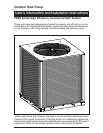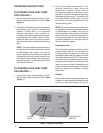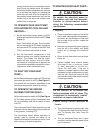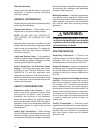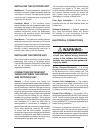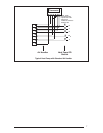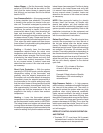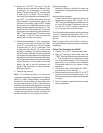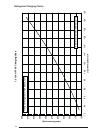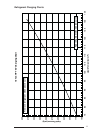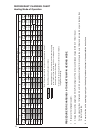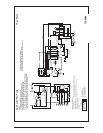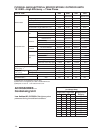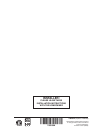
8
Indoor Blower — Set the thermostat function
switch to COOLING and the fan switch to ON.
Verify that the indoor blower is operating and
that airfl ow is not restricted. Set the fan switch
back to AUTO.
Low-Pressure Switch — A low-pressure switch
is factory-installed (see attached). This switch
is located in the suction line internal to the out-
door unit. The switch is designed to protect the
compressor from a loss of charge. Under normal
conditions, the switch is closed. If the suction
pressure falls below 5 psig, then the switch will
open and de-energize the outdoor unit. The
switch will close again once the suction pressure
increases above 20 psig. Please note that the
switch interrupts the thermostat inputs to the unit.
Thus, when the switch opens and then closes,
there will be a 5 minute short cycling delay before
the outdoor unit will energize.
Cooling — Gradually lower the thermostat
temperature setpoint below the actual room
temperature and observe that the outdoor unit
and indoor blower energize. Feel the air being
circulated by the indoor blower and verify that
it is cooler than ambient temperature. Listen
for any unusual noises. If present, locate and
determine the source of the noise and correct
as necessary.
Short Cycle Protection — With the system
operating in COOLING mode, note the setpoint
temperature setting of the thermostat, and
gradually raise the setpoint temperature until
the outdoor unit and indoor blower de-energize.
Immediately lower the setpoint temperature of
the thermostat to its original setting and verify
that the indoor blower is energized and that the
outdoor unit remains de-energized. Verify that,
after approximately 5 minutes, the outdoor unit
energizes and that the temperature of the air
supplied to the facility is cooler than ambient
temperature.
Heating — Lower the thermostat setpoint
temperature to the lowest obtainable setting and
set the thermostat function switch to HEATING.
The indoor blower and outdoor unit should stop
running. After a minimum of fi ve minutes, increase
the setpoint temperature of the thermostat to the
maximum setting. Verify that the outdoor unit and
indoor blower have energized. Feel the air being
circulated by the indoor blower and verify that
it is warmer than ambient temperature. Listen
for any unusual noises. If present, locate and
determine the source of the noise and correct
as necessary.
NOTE: Other sources for heating (i.e.: electric
furnace, fossil fuel furnace, air handler with
electric heat options, etc.) that interface with
the unit should be functionally checked to verify
system operation and compatibility. Refer to the
installation instructions for this equipment and
perform a functional checkout in accordance
with the manufacturer’s instructions.
Defrost Cycle Timer — The defrost cycle timer
controls the accumulated run time interval of
the hot gas defrost after the defrost sensor
closes. It is located in the upper right corner of
the defrost control board. Three interval settings
are available: 30 minutes, 60 minutes, and 90
minutes. Time setting selection is dependent on
the climate where the unit is being installed. The
default defrost cycle timer is set to 30 minutes. To
adjust the cycle time, move the jumper to cover
the two pins directly adjacent to the desired
cycle time.
Example 1. Dry climate of Southern
Arizona. A 90 minute setting is
recommended.
Example 2. Moist climate of Seattle,
Washington. A 30 minute setting is
recommended.
High-Pressure Switch — A high-pressure
switch is factory-installed and located in the liquid
line internal to the outdoor unit. The switch is
designed to protect the system when very high
pressures occur during abnormal conditions.
Under normal conditions, the switch is closed.
If the liquid pressure rises above 425 psig, then
the switch will open and de-energize the outdoor
unit. The switch will close again once the liquid
pressure decreases to 350 psig. Thus, when the
switch opens and then closes, there will be a 5
minute short cycling delay before the outdoor
unit will energize.
DEFROST CONTROL BOARD OPERATION
AND TESTING
1. Terminals “R”-”C” must have 24±V present
between them in order for the time delay and
defrost sequences to be operational.



